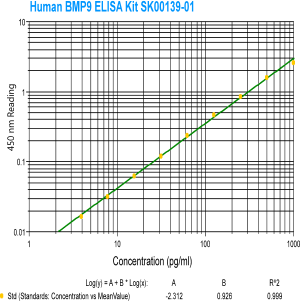
Bone Morphogenetic Protein 9 (BMP9) ELISA
|
|||||||||||
 |
Haman BMP9 ELISA Kit | ||||||||||
| Code No.: SK00139-01 Size: 96T Sensitivity: 3.9 pg/ml Standard rage: 7.8-500 pg/ml Sample type: Serum, Cell Cultures Sample Volume: 100 uL Intra CV: 4-6% Inter CV: 8-10% More Info: Protocol |
|||||||||||
| Human BMP-9/GDF-9 Recombinant Code No.: 00022-01-100 Size: 100 ug Price: $360.00 USD Protein ID:O60383 Gene ID:2661 MW:18 KD Tag: His Tag on N-Terminus Expressed: E. Coli Purity: 95% Data Sheet: PDF |
|||||||||||
| Name | Code No. |
Size |
Price ($) |
|
| BMP 9 (Human) ELISA Kit | serum,plasma | 96T |
360.00 |
|
| BMP 9/GDF-9 (Human) Recombinant | 100 ug |
360.00 |
||
Price/availability/specifications subject to change without notice. All products and services are for in vitro research use only. Not for use in or on humans or animals.